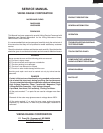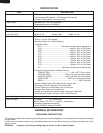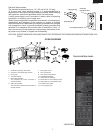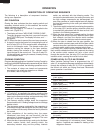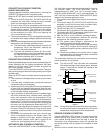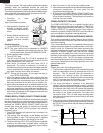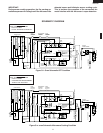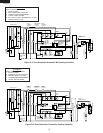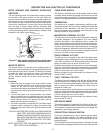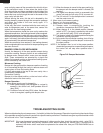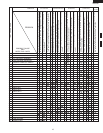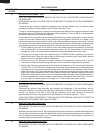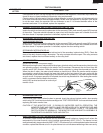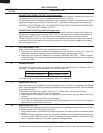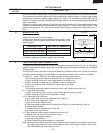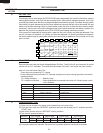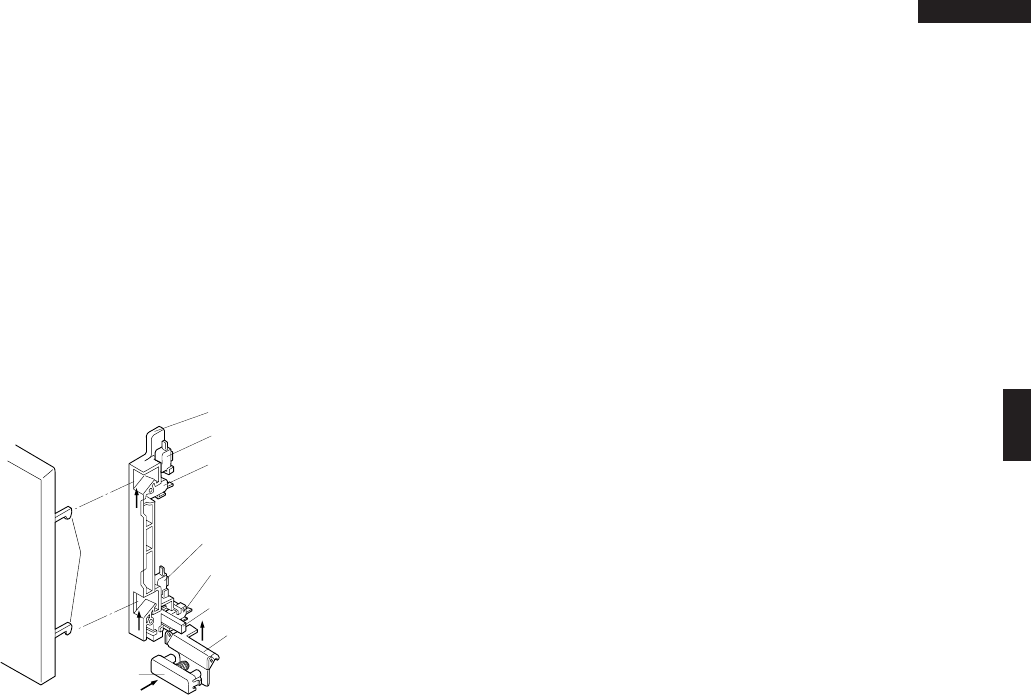
13
DMOC205SS
VMOC205SS
THIRD DOOR SWITCH
The switch is activated by the latch heads, while the door
is closed. When the door is opened, the switch interrupt the
circuit to the power transformer. This switch prevents power
transformer engaging and microwave when the door opened.
THERMISTOR
The thermistor is a negative temperature coefficient type.
The temperature in the oven cavity is detected through the
resistance of the thermistor, and then the control unit
causes the heater relay to operate, thus the current to the
heating element is turned ON/OFF.
MAGNETRON THERMAL CUT-OUT
The thermal cut-out located on the waveguide is designed
to prevent damage to the magnetron if an over heated
condition develops in the magnetron due to cooling fan
failure, obstructed air guide, dirty or blocked air intake, etc.
Under normal operation, the thermal cut-out remains closed.
However, when abnormally high temperatures are reached
within the magnetron, the thermal cut-out will open at 257
ο
F
(125
ο
C) causing the oven to shut down. magnetron thermal
cut-out is not reset at room temperature.
OVEN THERMAL CUT-OUT
The thermal cut-out located on the side of the steam duct
is designed to prevent damage to the unit if the foods in the
oven catch fire due to over heating produced by improper
setting of cooking time or failure of control unit.
Under normal operation, the thermal cut-out remains closed.
However, when abnormally high temperatures are reached
within the oven cavity, the thermal cut-out will open at 302
ο
F
(150
ο
C) causing the oven to shut down.
When the thermal cut-out has cooled, the thermal cut-out
closes at 266
ο
F (130
ο
C)
CONV. THERMAL CUT-OUT
The thermal cut-out located on the left side of the thermal
protection plate (left) is designed to prevent damage to the
heater unit if an over heated condition develops in the tube
due to cooling fan failure, obstructed air ducts, dirty or
blocked air intake, etc.
Under normal operation, the thermal cut-out remains closed.
However, when abnormally high temperatures are reached
within the heater unit, the thermal cut-out will open at 302
ο
F
(150
ο
C) causing the oven to shut down.
When the thermal cut-out has cooled, the thermal cut-out
closes at 266
ο
F (130
ο
C)
HEATING ELEMENT
The heating element is located at the left side of the oven
cavity. It is intended to heat air driven by the convection fan.
The heated air is kept in the oven and force-circulated and
reheated by the heating element.
CONVECTION COOKING SYSTEM
This oven is designed with a hot air heating system where
food is not directly heated by the heating element, but is
heated by forced circulation of the hot air produced by the
heating element.
The air heated by the heating element is circulated through
the convection passage provided on the outer casing of the
DOOR SENSING AND PRIMARY INTERLOCK
SWITCHES
The door sensing switch in the secondary interlock system
is mounted in the upper position on the latch hook, the
primary interlock switch is mounted in the lower position on
the latch hook. They are activated by the latch heads on the
door. When the door is opened, the switches interrupt the
circuit to all components. A cook cycle cannot take place
until the door is firmly closed thereby activating both
interlock switches. The secondary interlock system consists
of the door sensing switch and secondary interlock relay
located on the control circuit board.
DESCRIPTION AND FUNCTION OF COMPONENTS
Figure D-1. Door sensing switch, monitor switch, third
door switch and primary interlock switch
MONITOR SWITCH
The monitor switch is mounted on the middle position of
latch hook. It is activated (the contacts opened) by the lower
latch head while the door is closed. The switch is intended
to render the oven inoperative by means of blowing the
monitor fuse when the contacts of the relay RY1 and
primary interlock switch fail to open when the door is
opened.
Functions:
1. When the door is opened, the monitor switch contact
close (to the ON condition) due to their being normally
closed. At this time the door sensing and primary
interlock and third door switches are in the OFF condition
(contacts open) due to their being normally open contact
switches.
2. As the door goes to a closed position, the monitor
switch contacts are first opened and then the door
sensing switch, third door switch and the primary interlock
switch contacts close. (On opening the door, each of
these switches operate inversely.)
3. If the door is opened, and the relay RY1 and the primary
interlock switch contacts fail to open, the monitor fuse
blows simultaneously with closing of the monitor switch
contacts.
CAUTION: BEFORE REPLACING A BLOWN MONITOR
FUSE TEST THE DOOR SENSING SWITCH,
PRIMARY INTERLOCK SWITCH, RELAY(RY1)
AND MONITOR SWITCH FOR PROPER OP-
ERATION. (REFER TO CHAPTER “TEST PRO-
CEDURE”).
NOTE: MONITOR FUSE AND MONITOR SWITCH ARE
REPLACED AS AN ASSEMBLY.
LATCH HOOK
LATCH
HEADS
DOOR SENSING
SWITCH
MONITOR SWITCH
PRIMARY
INTERLOCK SWITCH
SWITCH LEVER
OPEN LEVER
DOOR OPEN
BUTTON
THIRD DOOR SWITCH



